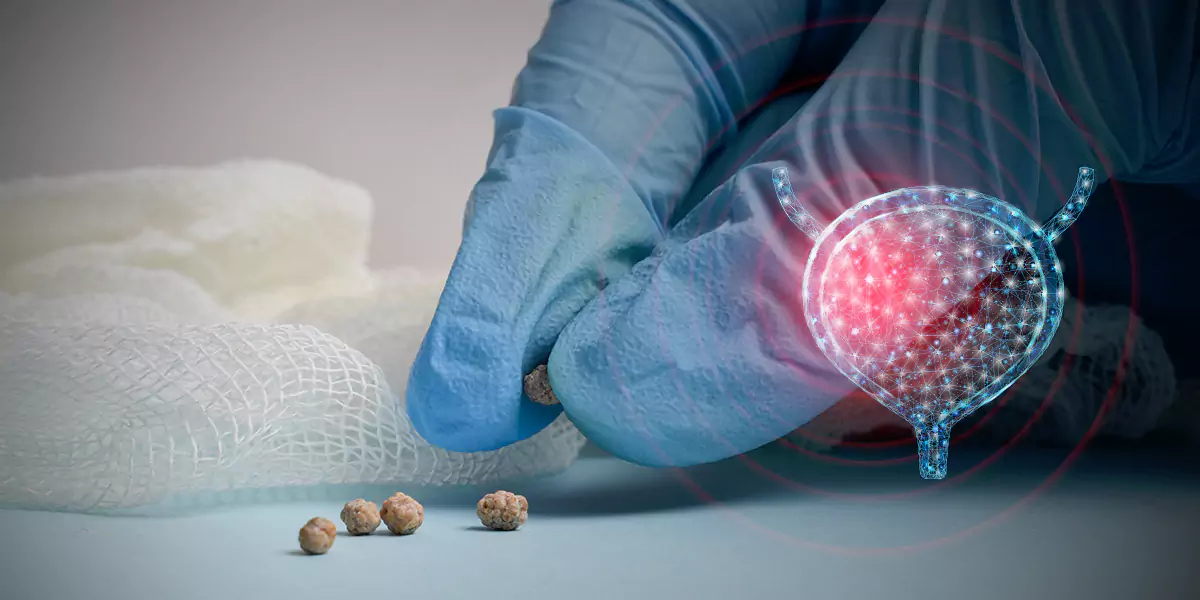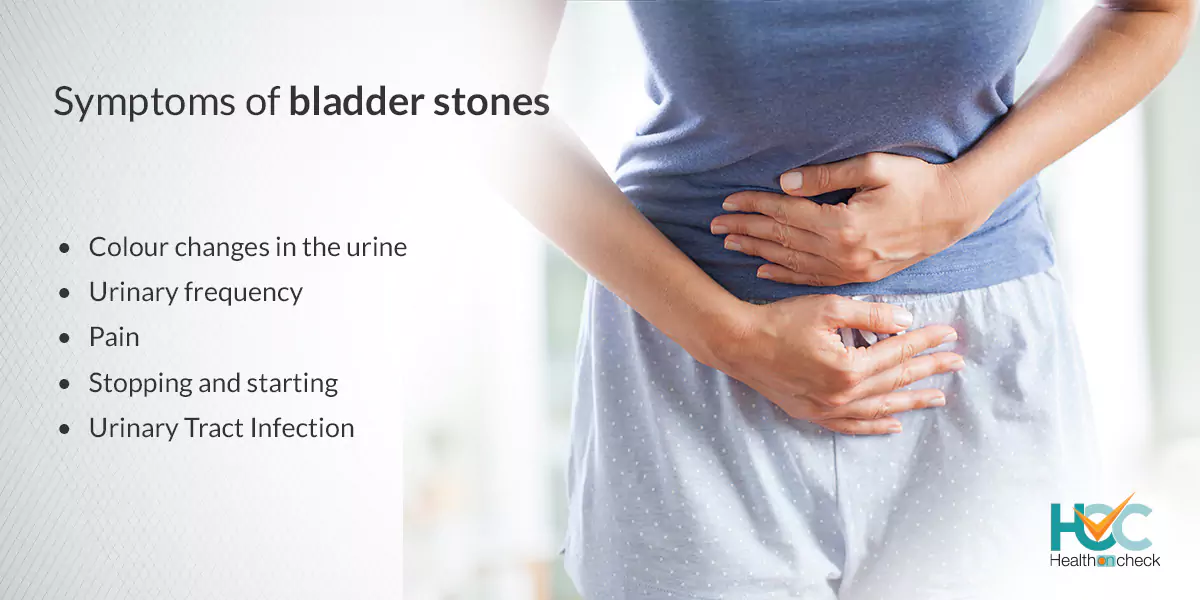All about Bladder Stones

What are Bladder Stones?
When the concentrated pee hardens in the bladder after urination, crystalline minerals known as Bladder Stones are created. Your pee contains almost 90% water. The remainder is made up of waste materials like protein and minerals like salt. Depending on the types of waste & minerals it contains, concentrated urine can range in colour from dark amber to brown.
Dehydration or the inability to fully empty your bladder can lead to concentrated urine. This might be brought on by urinary tract infections, an enlarged prostate, or bladder issues (UTIs). Bladder Stones can cause infections and other problems if they are not treated.
Are Kidney Stones & Bladder Stones the same?
Kidney Stones and Bladder Stones are two different things:
The bladder is where most Bladder Stones will develop. However, Kidney stones may become so tiny that they can descend via the ureters and enter the bladder (the tubes running from the kidney to the bladder). In this situation, Bladder Stones could develop from Kidney Stones.
These stones may leave the body when they are still extremely small. Other times, Bladder Stones may slowly accumulate more mineral crystals, growing larger and more difficult to pass.
How prevalent are incidences of Bladder Stones?
While bladder stones can occur in both men and women, they are more common in men over 50 and are typically brought on by an enlarged prostate gland or another sort of bladder obstruction.
In children, bladder stones are uncommon. They might also result in bedwetting.
What are the symptoms of bladder stones?
Some bladder stones move through the body and out through the urine without causing any symptoms. Large bladder stones can aggravate the bladder and result in excruciating discomfort, bleeding, and urination issues. Some warning signs and symptoms are:
- Colour changes in the urine: Urine may be black or cloudy, or it may contain visible blood.
- Urinary frequency: Even if you just went, you could feel the need to urinate frequently.
- Pain: When peeing, bladder stones frequently cause pain or burning. Additionally, you can experience intermittent lower abdominal pain (belly). Men occasionally have pain in their testicles or penis.
- Stopping and starting: Even if you truly need to go, you could have trouble commencing the flow of pee. The urine stream can occasionally cease and start (urinary intermittency).
- Urinary Tract Infection: Bladder stone infections can result in infections of the urinary tract (UTIs). Frequent, painful urination and murky, odorous urine are both UTI symptoms.
What is the cause of Bladder Stones?
When pee stays in the bladder for too long, bladder stones develop. Urine concentrates when it sits in the bladder for too long, and minerals in the urine solidify and coalesce into crystals. When your bladder cannot be fully emptied, this process takes place.
Bladder stones are more likely to form due to a number of conditions and circumstances, including:
- Augmentation cystoplasty: In an augmentation cystoplasty or a bladder augmentation treatment, healthcare experts employ intestinal tissue to enlarge the bladder & its functionality. Urine occasionally collects in the bladder because of the treatment.
- Bladder diverticula: Some pockets or pouches in the bladder are hard to empty completely. This condition can happen at the time of birth. It can also develop later in life because of disease or enlarged prostate.
- Dehydration: Water dilutes the minerals in the pee and flushes it out of the bladder. Dehydration can also lead to bladder stones as minerals tend to build up in the urine.
- Enlarged prostate: As men age, the prostate can enlarge, putting pressure on the urethra, which is the tube that carries pee from the kidneys to the bladder). The added pressure can make it difficult to completely empty the bladder.
- Cystocele: After childbirth, some women develop a condition known as a cystocele. Weakening bladder walls fall into the vagina and obstruct urine flow.
- Stones in the kidney: Kidney stones are similar to bladder stones. A kidney stone can sometimes pass from your kidney into your bladder. If the stone can pass into the bladder, it is usually easily urinated out of the bladder. Very rarely, in patients who have difficulty urinating, the stone can become stuck and grow larger inside the bladder, causing pain while peeing.
- Neurogenic bladder: Nerve damage caused by a spinal cord injury, stroke, other diseases, or congenital abnormality (such as spina bifida) can impair bladder function. People with neurogenic bladder frequently require the use of a catheter (a thin, flexible tube) to drain their bladder. Catheters cannot always drain all of the urine.
- Medical equipment: Patients who have bladder devices, such as catheters, may develop bladder stones as a result of crystals that form on the device. This is usually the case if the device has been in the body for a longer period of time than recommended.
What are the risk factors for Bladder Stones?
The following are some risk factors for Bladder Stones:
- Age and gender: Males are more likely than females to develop bladder stones, especially as they age.
- Paralysis: People suffering from spinal injuries, paralysis or loss of muscle control in the pelvic area are unable to completely empty their bladder.
- Bladder outlet obstruction: Any condition that prevents urine from flowing through the bladder to the outside of the body. The bladder can become blocked in various ways, the most common of which is an enlarged prostate.
How are Bladder Stones diagnosed?
Your doctor will examine you and inquire about your symptoms. He may advise you on the following tests to diagnose bladder stones:
- Urine test: Your healthcare provider sends a urine sample to a lab to be checked for small bladder stones. The lab will also look for signs of urinary tract infection or blood in your urine.
- Imaging tests: Computed tomography (CT) scans, X-rays, and ultrasound images provide your provider with clear images of your bladder. These examinations reveal the size, shape, and location of bladder stones.
- Cystoscopy: During this procedure, your provider looks inside your bladder with a small scope to look for stones. The scope is flexible and thin, with a camera on end.
What is the treatment for Bladder Stones?
If bladder stones are found when they are small, simply increasing the amount of water consumed by the individual may be sufficient naturally pass them.
If the bladder stones are too big to pass through the urine, they are usually broken up or removed surgically.
Removing bladder stones
The expert inserts a thin tube which comes with a specialised camera on end into the urethra in a procedure known as “cystolitholapaxy” which is opening at the end of the male penis or above the female vagina). The doctor can see the stones and break them down through the tube.
The doctor will break up the stones with a laser, ultrasound, or a small tool before washing (or vacuuming) them away. This procedure is performed under general anaesthesia.
Cystolitholapaxy complications are uncommon, but they can include bladder wall tears and infections.
Surgical extraction
If the stones are too large to be broken down with cystolitholapaxy, surgery is an option.
The surgeon will enter the bladder via an abdominal cut and remove the bladder stones. Because any surgical procedure carries some risk, cystolitholapaxy is always the first option when possible.
What are complications related to Bladder Stones?
Bladder stones that do not pass, even if they do not cause symptoms, can cause complications such as:
Chronic bladder issues
Untreated bladder stones can result in long-term urinary issues such as pain or frequent urination. Bladder stones can also become lodged in the opening where urine exits the bladder and enters the urethra, obstructing urine flow.
Infections of the urinary tract
Bladder stones can cause recurrent bacterial infections in your urinary tract.
What are the ways to prevent Bladder Stones?
There are no specific ways to prevent bladder stones because they can be caused by various medical conditions.
However, if a person has any unusual urinary symptoms, it is best to seek the advice of a healthcare professional as soon as possible.
Unusual urinary symptoms may include:
- pain
- discolouration
- blood
Drinking plenty of fluids will assist in the breakdown of any developing stones. Drinking at least 8 cups of water per day is recommended by experts.
Some people with urinary tract infections may experience the sensation that there is urine left in their bladder after urinating. It is best to try peeing 10-20 seconds again after the first attempt in these cases. This is known as “double voiding,” and it can help prevent the formation of stones.
Whom to consult?
If you are facing problems such as pain, stopping and starting over and over, or peeing too often, then consult your physician or a urologist.





